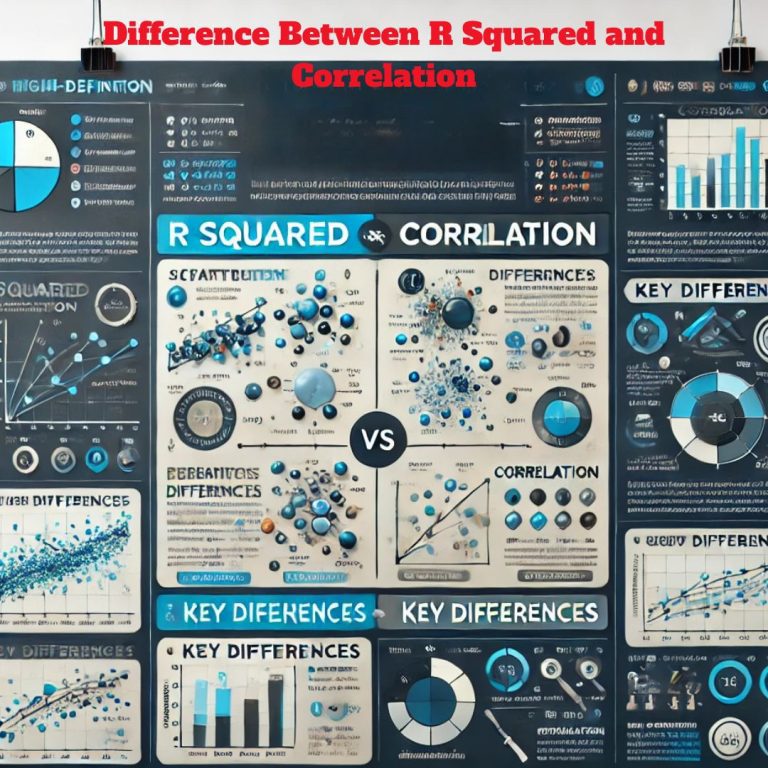The difference between R squared and correlation is a common question in statistics, particularly when dealing with regression analysis and the relationship between two variables. Both R squared and correlation measure the strength and direction of relationships, but they differ in how they are calculated and what they represent. While correlation focuses on the strength and direction of a linear relationship between two variables, R squared explains the proportion of variation in one variable that can be explained by the other.
Introduction to R Squared and Correlation: Defining the Concepts
In the realm of statistics, R squared and correlation are two key concepts used to quantify relationships between variables. The difference between R squared and correlation primarily lies in their interpretation and application. Correlation is a measure that indicates the strength and direction of a linear relationship between two variables. It is expressed as a value between -1 and +1, where +1 indicates a perfect positive relationship, -1 indicates a perfect negative relationship, and 0 indicates no linear relationship. On the other hand, R squared (also known as the coefficient of determination) is a statistical measure that represents the proportion of the variance in the dependent variable that is predictable from the independent variable(s) in a regression model. While both provide insights into relationships, R squared is generally used in the context of regression analysis, and correlation is often used in simpler bivariate analyses.
Understanding R Squared: What It Measures and How It’s Used?
R squared, or the coefficient of determination, is a statistical measure that tells us how well the data fits a regression model. In other words, it quantifies the proportion of variance in the dependent variable that can be explained by the independent variable(s). R squared values range from 0 to 1, with a higher value indicating that the model explains a larger proportion of the variance.
How is R Squared Calculated?
The calculation of R squared is based on the total variation in the dependent variable and how much of that variation can be explained by the independent variables in a regression model. It can be represented as:
- SST (Total Sum of Squares): This represents the total variation in the dependent variable.
- SSR (Sum of Squares of Residuals): This represents the unexplained variation after fitting the model.
Interpreting R Squared
- An R squared value of 0 means that the independent variable(s) do not explain any of the variance in the dependent variable.
- An R squared value of 1 means that the independent variable(s) explain all of the variance in the dependent variable.
- For example, if the R squared value of a model is 0.85, this means that 85% of the variance in the dependent variable is explained by the independent variable(s), and the remaining 15% is unexplained.
Applications of R Squared
- Regression Analysis: R squared is often used to assess how well a regression model fits the data. It helps evaluate the model’s predictive power and the strength of the relationship between the independent and dependent variables.
- Model Selection: R squared is used to compare different models. A higher R squared indicates a better fit, though it should not be used as the sole criterion for model selection.
Limitations of R Squared
- Overfitting: R squared always increases as more predictors are added to the model, even if those predictors do not improve the model’s actual performance. This can lead to overfitting.
- No indication of causality: R squared does not imply a causal relationship between the variables; it only measures the strength of the relationship.
Explaining Correlation: Significance and Interpretation
Correlation is a statistical measure that describes the direction and strength of a linear relationship between two variables. The correlation coefficient, typically denoted as r, can range from -1 to +1:
- r = +1: Perfect positive linear relationship (as one variable increases, the other increases).
- r = -1: Perfect negative linear relationship (as one variable increases, the other decreases).
- r = 0: No linear relationship (the variables do not have any linear association).
How is Correlation Calculated?
Correlation is calculated using the formula:
Where:
- x and y are the individual data points of the two variables.
- n is the number of data points.
Interpreting Correlation
- Positive Correlation: When the correlation coefficient is positive (r > 0), it indicates that as one variable increases, the other variable tends to increase as well.
- Negative Correlation: When the correlation coefficient is negative (r < 0), it suggests that as one variable increases, the other decreases.
- Zero Correlation: A correlation of 0 means that there is no linear relationship between the two variables.
Applications of Correlation
- Data Analysis: Correlation is commonly used in data analysis to identify relationships between variables.
- Forecasting: In predictive analytics, correlation can help determine which variables are likely to move together and assist in forecasting trends.
- Risk Management: In finance, correlation is used to understand the relationship between asset prices, helping investors diversify portfolios and manage risk.
Limitations of Correlation
- Causality: Correlation does not imply causality. Even if two variables are correlated, it doesn’t mean that one causes the other.
- Linear Relationships: Correlation only measures linear relationships. Non-linear relationships might not be captured by the correlation coefficient.
Key Differences Between R Squared and Correlation: A Detailed Comparison
| Aspect | R Squared | Correlation |
| Definition | Represents the proportion of variance in the dependent variable explained by the independent variable(s). | Measures the strength and direction of a linear relationship between two variables. |
| Value Range | 0 to 1 (0% to 100%) | -1 to +1 |
| Context of Use | Used in regression analysis to evaluate model fit. | Used in bivariate analysis to measure the linear relationship. |
| Interpretation | Tells us how well the model explains variation. | Tells us the strength and direction of the relationship. |
| Calculation | Calculated from the residual sum of squares. | Calculated from covariance of the two variables. |
| Measurement Type | Measures explained variance. | Measures linear relationship (direction and strength). |
Key Takeaways
- R Squared: Focuses on the proportion of variance explained by the model in a regression context.
- Correlation: Focuses on the strength and direction of a linear relationship between two variables.
- Both measures are related but serve different purposes in statistical analysis and modeling.
Conclusion
In conclusion, understanding the difference between R squared and correlation is essential for correctly interpreting statistical analyses. R squared is used primarily in regression analysis to assess how well a model explains the variance in the dependent variable, while correlation measures the strength and direction of a linear relationship between two variables. Both are valuable tools, but they provide different insights. R squared is more about model fit, while correlation is about the relationship between two variables, making them useful in different contexts.
Difference Between R Squared and Correlation FAQs
What is the key difference between R squared and correlation?
The key difference is that R squared measures how much of the variance in one variable can be explained by another variable in a regression model, while correlation measures the strength and direction of a linear relationship between two variables.
Can R squared be negative?
No, R squared cannot be negative. It ranges from 0 to 1, where 0 indicates no explanatory power and 1 indicates a perfect fit.
What does a correlation of 0 mean?
A correlation of 0 means there is no linear relationship between the two variables.
How is correlation different from causality?
Correlation does not imply causality. Just because two variables are correlated does not mean one causes the other.
Can R squared be used for non-linear relationships?
No, R squared is designed to measure the explanatory power of linear relationships. For non-linear relationships, other methods like non-linear regression may be more appropriate.


